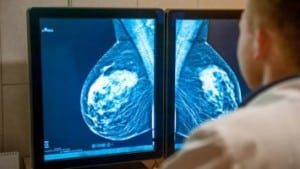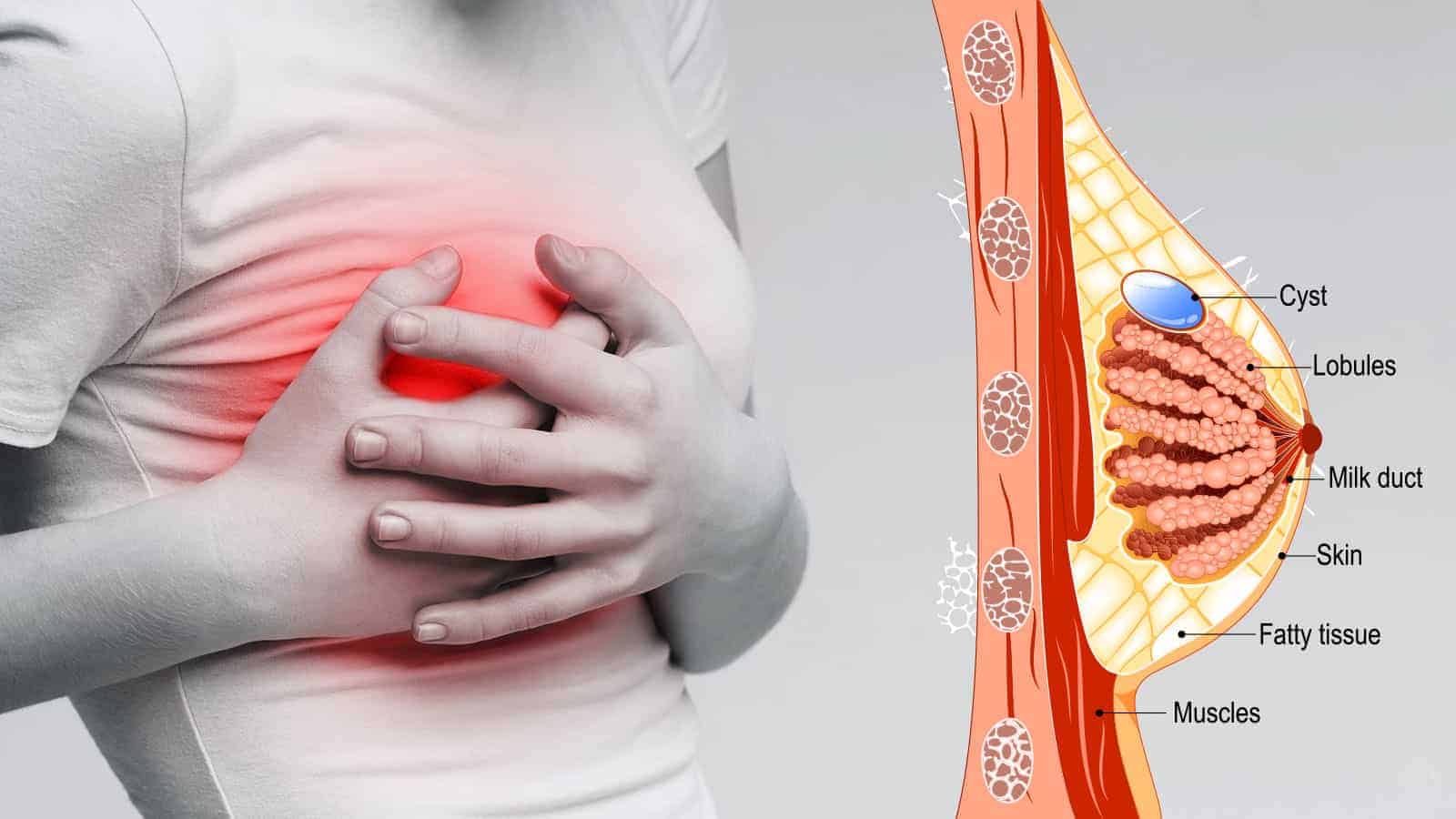Most women will experience mild breast pain at some point in their lives. However, only fifteen percent of all these cases require medical treatment.
Surprisingly to most, men may also experience twinges of tenderness in their breast tissue.
You can have breast pain in different locations. It can be on one breast, or it can be on both breasts. You can even experience this pain in your underarm.
Additionally, breast pain comes in different levels of severity. It can be mild, or it can be excruciatingly painful. These different levels of discomfort are commonly described as tenderness, tightening, throbbing, or sharp burning of the breast tissue.
Breast pain causes can vary. One of the most frequent reasons is hormonal changes. These changes can also affect the type of pain that you experience. This situation also explains why your perfectly healthy breasts can be in pain.
Here is a listing of ten of the most common causes of breast pain, as well as their treatment.
1. Cyst
Cysts are breast pain causes characterized by small sacs in the breast that fill with fluid. They are oval lumps that are soft and round typically. They can also feel hard in some cases.
Cysts can appear in one or both breasts, and you can have one or many cysts at a time. Apart from pain and tenderness, there are no other symptoms of cysts. These lumps grow and increase in pain during your period, and the effects reduce at the end of the period.
For treatment, visit your doctor so that they can confirm that it is indeed a cyst and not something serious. In case you have symptoms, use pain relievers such as naproxen and ibuprofen or use a compress to reduce the pain. Also, eat less salt to avoid swelling and pain.
2. Infection
The infection that occurs in the breast is called mastitis. This occurrence usually happens to women that breastfeed. Regardless, it can also happen to anyone.
Mastitis symptoms occur suddenly, and they include pain, burning, redness, chills, swelling, warmth, and fever.
In case you experience any symptom of infection in your breast, ensure that you see your doctor immediately. Your physician can guide you on whether you need an antibiotic and advise you of at-home care.
Also, sip a lot of fluids and get enough rest.
Besides, do not wear bras or clothes that are tight until your infection clears and increase feeds if you are breastfeeding since it will reduce pain.
Do not ignore the treatment of mastitis because it can grow into an abscess.
3. Fibrocystic Breasts
The changes in fibrocystic breasts are a common cause of pain in the breasts. About fifty percent of women will experience this type of pain during one point in their lives. Also, this breast tissue does not have any symptoms.
However, when symptoms occur, they include tenderness, pain, and a rope-like texture. The symptoms appear mostly in the area outside and on top of the breast.
To alleviate pain from fibrocystic breasts, use over the counter pain relievers such as ibuprofen and Acetaminophen. You can also apply a heated compress or a hot water bottle to reduce the pain.
Other methods that will help to reduce the pain include the use of a supportive bra and the use of hormonal birth control.
Nevertheless, ensure that you visit a doctor if you notice a new or bigger lump, increasing pain or changes that persist after your period.
4. Hormone Medications
Some hormonal medications’ side effects can be breast pain causes. For instance, oral contraceptives can cause breasts to experience pain. Hormone supplements and replacements can also cause this type of pain.
To treat these side effects, ask your doctor if they can prescribe a different medication. You might find that you tolerate a different brand better than the one you use.
If you are under hormonal birth control, you can switch to condoms, try a hormonal IUD, or try a copper hormone-free IUD.
5. Breastfeeding
When you first start breastfeeding your child, you might experience sore nipples. If the latch is not put properly, you can also experience severe breast pain. It is also widespread for the nipple to crack and become dry.
Other conditions that can be caused by breastfeeding include lactation mastitis, engorgement, plugged ducts, and fungal infections — mastitis results in pain, redness, and symptoms similar to the flu.
Engorgement results from an excess supply of milk that causes pain. It can also lead to plugged ducts. Plugged ducts are often in one breast, and they feel like a sore tender lump.
Fungal infections such as yeast infections can precipitate pain, aching, and itchiness. For treatment, ask a lactation consultant to help in case you have raw and sore nipples. They will advise you on the different feeding techniques and positions that you can use.
To soften hard breasts, you can pump milk in between feedings, apply a few drops of your milk around your nipples after feeding to soothe cracking and apply a warm compress to the plugged milk ducts.
Also, use breathable cotton pads to reduce trapping of moisture.
6. Pregnancy
Pregnancy triggers many hormonal changes in a female’s body. This is because the hormones are responsible for triggering the transformations that are required to support a pregnancy.
Hence, your breasts may become tender and swollen, and your nipples might stick out. In case the pain in your breast becomes severe, you should see your OB-GYN. Additionally, inform them of any skin changes, discharge, or lumps.
Otherwise, treat the soreness with a heat compress, use breast pads to prevent the chaffing of the nipple, wear your bra to bed, avoid touching your breast, and get a new loose bra.
7. Period
A woman’s monthly cycle is one of the most common breast pain causes. This is a result of the hormonal changes that occur during their period. The medical term for this form of pain is cyclical breast pain.
Throughout the month, estrogen and progesterone hormones will fluctuate in your body. As a result, you will experience a lot of havoc in your brain as well as your body. These two hormones can increase the size of ducts and glands in your breast.
Therefore, your breast swells and retain water. The breasts also become tender, lumpy, and painful a few days to your period. This type of pain usually fades after the period ends.
Regardless, you can change your lifestyle and use home remedies to relieve these symptoms by wearing a period bra, avoiding caffeine, reducing salt intake, practicing mindfulness, applying a hot or a cold compress, and using a pain reliever.
If the home remedies do not work, your doctor can prescribe hormonal birth control to reduce your premenstrual symptoms.
8. Bruises or Bumps
At one point in your life, you have woken up with an injury that you do not remember getting. The same philosophy can apply to your breast.
For instance, if you bump yourself while you carry a heavy sleeping child, it might cause a bruise.
Treating a minor bruise or bump is unnecessary because it will fade away in time. If you want to ease your symptoms, however, you can take a pain reliever such as naproxen or ibuprofen.
You can also apply a compress in your breast to relieve the pain and change the bra that you wear to make your chest more comfortable.
9. Muscle Strain
The muscles that lie directly below and around your breasts are known as the pectoral muscles. When this muscle is strained, it feels as though the pain is coming from your chest. As a result, these types of breast pain causes are limited to one breast.
Together with this pain, you might also experience bruising, swelling, and difficulty when moving your shoulder. The cause of this pain makes it common among weight lifters, athletes, and any other person engaging in activities that can lead to strain.
To treat muscle strain, you can use over the counter medications such as naproxen and ibuprofen. You can also do stretching exercises such as yoga or Pilates. A heating compress can also reduce the pain that you feel and make it easy to reach.
You can also rest to stimulate healing.
10. Bra
The work of a bra is to give support to the fatty tissues and weight of breast tissue. This necessity is especially true if you have a big cup size. Besides, in most cases, you will find that many women do not wear bras that fit their sizes appropriately.
If you wear an ancient bra, stretched out, or one that is too big, you will not be giving your breasts the support that they require. Hence, letting your breasts jostle around from morning to evening can make them sore. The unpleasant feeling can also spread into your shoulders, neck, and back.
On the other hand, if you wear a bra that is too tight, the excess pressure on your breasts can lead to sensitivity. Therefore, if you think that your bra might be causing your breast pain, consider the following:
• Check whether your breasts often spill over the top of your bra
• Confirm if your backs strap is digging into your skin
• Confirm if your bra is on its loosest or tightest buckle
• Check and see if the bra rides up in the back
• Confirm for spaces between the bra cup and your breast
If any of these conditions sound eerily like you, get a professional fitting in a store near you to get your exact bra size.

A mammogram is the best tool to detect whether your breast pain is anything to worry about.
Final Thoughts on Dealing with Breast Pain
Always visit the doctor if the breast pain becomes severe. Also, visit your doctor if you have unusual discharge, fever, chills, and persistent swelling. Finally, schedule your regular mammograms and alert your doctor if you find any new lumps, bumps, changes in the skin, or other changes to your breast tissue.

















